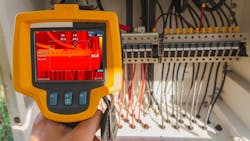How to detect temperature variations in industrial environments
Detecting anomalous heat in industrial environments requires purpose-built technology. Infrared and thermography solutions help to identify and quantify issues such as hot spots, leaks, asset degradation, and process concerns. Tools offering greater temperature ranges, resolution, durability, and analytics facilitate condition monitoring, inspections, and predictive maintenance.
Targeted solutions
Recent innovations address common challenges. The Titan HD from Infrared Cameras, Inc. (ICI) is a high-resolution thermal imaging camera designed for surveying large and distant critical assets and infrastructure. The lightweight device measures temperatures up to 1,500 °C (2,732 °F) to an accuracy of 1 °C, even from a significant distance.
The handheld Titan HD and its fixed-mount sibling unit, Titan 1280P, provide notable granularity. “The 1,280 × 1,024 pixel count of the infrared detector itself equates to more than 1.3 mm individual temperature points within the image,” observes Carl Schultz, director of product knowledge at ICI. "The top-tier sensor and its ability to interface with ICI's SmartIR platform provides end users with a myriad of control, integration, monitoring, reporting, and process control options and opportunities."
The new utility-grade TS3700 thermal imaging sensor from Systems With Intelligence is a continuous thermal monitoring solution for substations with built-in temperature analytics and alarms. The sensor can be set up to automatically scan remote sites, provide temperature readings on hundreds of points, and send alarms through email or to the SCADA system. Its protective housing is built to withstand extreme conditions to support a high level of uninterrupted operation.
Richard Harada, a vice president at Systems With Intelligence, says the company’s thermal monitoring solutions are “specifically designed to endure the harsh environments in electrical substations and industrial sites, while seamlessly interfacing with SCADA and asset management platforms.”
Continuous detection of slag, an unwanted steel production byproduct, helps to improve steel quality and reduce energy consumption and emissions such as CO2. AMETEK Land’s Slag Detection System (SDS v2) and integrated MWIR-640 SDS mid-wavelength thermal imager enables reliable and continuous slag detection, monitoring, and process control. The system’s image processing workstation with IMAGEPro v2-SDS software triggers an alarm when threshold levels are exceeded.
“The new MWIR-640 SDS thermal imager unit, with an advanced 3.9 µm spectral response, provides the clearest view through smoke, particles, and hot process gases,” notes Manfred Hayk, global product manager of IR at AMETEK Land. “The system is designed to provide accurate, real-time detection of steel/slag, independent of charge weight and without operator intervention.”
New lines of fixed and handheld infrared temperature systems from Palmer Wahl Instruments are available in ten different spectral ranges “to measure everything from loaves of bread to 3,000 °C (5,432 °F) steel,” says President Stephen Santangelo.
Wahl’s Heat Spy Monitor R40 Series Fixed Infrared Sensors are all-in-one systems available with a full complement of accessories to optimize installation. The sensors come equipped with signal processing tools that can be adjusted using a built-in keypad. Wahl’s DHS40 Series Heat Spy Handheld Infrared Pyrometers uniquely have an all-metal housing for increased durability and are available in models for measuring cold metal, through flame, burning gas, glass, and thin-film plastics.
Advanced reporting and analysis
Using infrared thermography for condition monitoring involves more than just an effective thermal imaging camera. “Now, it is essential also to have the right image analysis and reporting software,” says Rob Milner, director of business development at Teledyne FLIR. The company’s new E8 Pro is an example.
The FLIR E8 Pro “includes the FLIR Ignite cloud service, empowering users to upload images directly to the cloud, organize and edit files, and create simple reports. For more advanced editing and reporting, there's FLIR Thermal Studio Suite, a desktop software offering batch processing, feature-rich measurement tools, and customized reports,” adds Milner. The camera’s one-hand operation, 3.5-inch touchscreen, and patented Multi-Spectral Dynamic Imaging (MSX) increase usability.
BAM, a senior scientific and technical federal institute based in Berlin, and LATODA, an AI-as-a-Service start-up, co-developed a method to inspect wind turbine rotor blades from the ground for erosion damage. An infrared camera system takes thermographic images of rotor blades, and the images are analyzed using AI, enabling targeted maintenance to improve turbine efficiency and performance. The solution was successfully tested in a feasibility study.
“An automated image evaluation with artificial intelligence represents a great potential to decide even faster and more reliably after the measurement which concrete measures are to be initiated by the operators of the turbines," explains Michael Stamm, head of the project at BAM.
About the Author

Sheila Kennedy
CMRP
Sheila Kennedy, CMRP, is a professional freelance writer specializing in industrial and technical topics. She established Additive Communications in 2003 to serve software, technology, and service providers in industries such as manufacturing and utilities, and became a contributing editor and Technology Toolbox columnist for Plant Services in 2004. Prior to Additive Communications, she had 11 years of experience implementing industrial information systems. Kennedy earned her B.S. at Purdue University and her MBA at the University of Phoenix. She can be reached at [email protected] or www.linkedin.com/in/kennedysheila.
